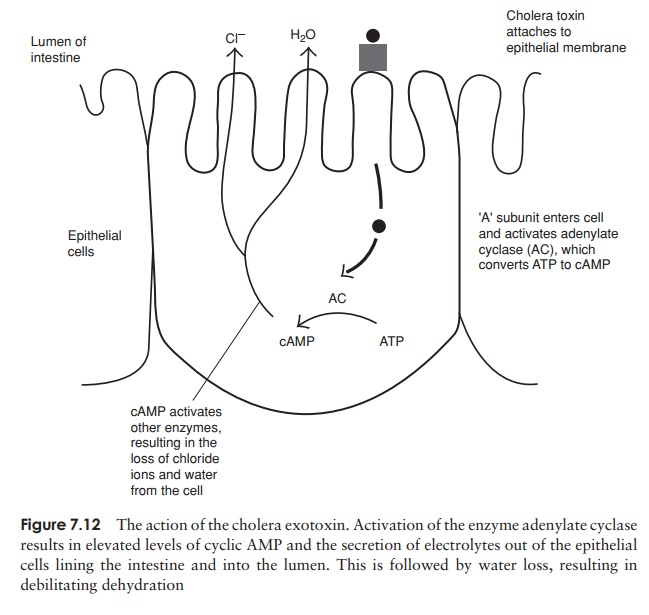Chapter: Essential Microbiology: Procaryote Diversity
Bacteria and human disease
Bacteria and human disease
Although a detailed discussion of bacterial diseases falls outside the remit of this in-troductory text, their effect on the human race is too huge to fail to mention them completely. Some important examples have been mentioned briefly in the preceding text and Table 7.5 summarises the principal bacterial diseases of humans. This chap-ter about bacteria concludes with a brief discussion of four bacterial diseases, each providing an example of a different mode of transmission.

Waterborne transmission: cholera
The causative agent Vibrio cholerae is ingested in faecally contaminated water or food. The bacteria attach by means of adhesins to the intestinal mucosa, where, without actually penetrating the cells, they release the cholera exotoxin. This comprises an ŌĆśAŌĆÖ and several ŌĆśBŌĆÖ subunits; the former is the active ingredient, while the latter attach to epithelial cells by binding to a specific glycolipid in the membrane. This allows the passage of the ŌĆśAŌĆÖ subunit into the cell, where it causes the activation of an enzyme called adenylate cyclase (Figure 7.12). This results in uncontrolled production of cyclic AMP, causing active secretion of chloride and water into the intestinal lumen. The outcome of this is huge fluid loss (10 l or more per day) through profuse and debilitating diarrhoea. In the young, old and sick, death through dehydration and salt depletion can follow within a very short time. If proper liquid and electrolyte replacement therapy is available, recovery rates can be very high. Although it is now very rare in the developed world (in 2002, only two cases were reported in the USA), cholera is a major killer in the third world. It is easily preventable by means of clean water supplies and improved

Airborne transmission: ŌĆśstrepŌĆÖ throat
Streptococcal pharyngitis, commonly known as strep throat, is one of the commonest bacterial diseases of humans, being particularly common in children of school age. The primary means of transmission is by the inhalation from coughs and sneezes of respi-ratory droplets containing Streptococcus pyogenes (╬▓-haemolytic type A streptococci), although other routes (kissing, infected handkerchiefs) are possible. The primary symp-toms are a red and raw throat (and/or tonsils), accompanied by headaches and fever. S. pyogenes attaches to the throat mucosa, stimulating an inflammatory response andsecreting virulence factors that destroy host blood cells. Although self-limiting within a week or so, strep throat should be treated with penicillin or erythromycin as more serious streptococcal diseases such as scarlet fever and rheumatic fever may follow if it is left untreated.
Contact transmission: syphilis
Causative organisms of sexually transmitted diseases such as Neisseria gonorrhoeae (gonorrhoea) and Treponema pallidum (syphilis) are extremely sensitive to the effects of environmental factors such as UV light and desiccation. They are therefore unable to live outside of their human host, and rely for transmission on intimate human contact.
The spirochaete T. pallidum enters the body through minor abrasions, generally on the genitalia or mouth, where a characteristic lesion called a chancre develops. The disease may proceed no further than this, but if T. pallidum enters the bloodstream and passes around the body, the more serious secondary stage develops, lasting some weeks. Following a latent period of several years, around half of secondary syphilis cases go on to develop into the tertiary stage of the disease, whose symptoms may include mental retardation, paralysis and blindness. Congenital syphilis is caused by T. pallidum being passed from a mother to her unborn child.
The primary and secondary stages of syphilis are readily treated by penicillin; how-ever, the tertiary stage is much less responsive to such therapy.
Vector-borne transmission: plague
A limited number of bacterial diseases reach their human hosts via an insect intermediary from their main host, usually another species of mammal.
Plague (bubonic plague, the Black Death) has been responsible for the deaths of untold millions of people in terrible epidemics such as the ones that wiped out as much as one-third of the population of Europe in the Middle Ages. It is caused by the Gram-negative bacterium Yersinia pestis, whose normal host is a rat, but can be spread to humans by fleas. The bacteria pass to the lymph nodes, where they multiply, causing the swellings known as bubos. Y.pestis produces an exotoxin, which prevents it from being destroyed by the hostŌĆÖs macrophages; instead, it is able to multiply inside them.
From the lymph nodes, the bacteria spread via the bloodstream to other tissues such as the liver and lungs.
Once established in the lungs (pneumonic plague), plague can spread from human to human by airborne transmission in respiratory droplets. Untreated, plague has a high rate of fatality, particularly for the pneumonic form of the disease. Early treatment with streptomycin or tetracycline, however, is largely successful. Improved public health measures and the awareness of the dangers of rats and other rodents have meant that confirmed cases of plague are now relatively few.
Related Topics